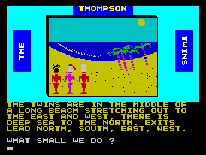
« PREVIOUS ENTRY
Collision Detection on hold for a few days
NEXT ENTRY »
Catty: The chatbot with a Google brain

Few people know that “modem” stands for “modulate/demodulate” — and only true geeks actually know what that means. It’s a description of how modems work: They take digital data and turn all the 1s and 0s into sound, so that it can be transmitted over an audio device like a phone. Back in the early days of computers, when nobody had hard drives, the only way to save a program was to actually shove it out your computer’s modem and store it on a cassette tape as sound. Back when I was a kid, I used to occasionally “listen” to the programs I had stored on a tape, to see if I could actually hear any patterns in the data.
But of course, that means that programs can be stored on anything that can play audio, including … vinyl albums. And as it turns out, there was quite a trend back in the early 80s for new-wave pop stars to include programs as audio tracks on their albums. To actually use the programs, you were forced to perform one of the strangest data transfers in the history of computing: You’d blast the screeching, modem-like data noise out your record player, record it into a cassette recorder, then play the cassette on a computer cassette-storage-device. Whoa.
There’s a brilliant web site cataloging some of these deranged pop-album-program experiments. In 1984, for example, the Thompson Twins released “The Thompson Twins Adventure game”, which is pictured above:
The game is a bizarre text-based adventure in which you guide the Thompson Twins around a land of beaches and caves. If you didn’t grow up playing these games, in which you have to keep a map on paper and guess which key verbs the programmers used for certain actions, you may find it a bit frustrating.
Even more deranged was an experiment by Pete Shelly, former leader of the Buzzcocks: The last track of his album XL-1 was the acoustic imprint of a program that, if you started it running at the precise instant that you began listening to the album, would display kitschy graphics and lyrics in time with each song. In essence, it was a sort of jurassic ancestor of a bonus-track DVD.
My favorite, though, is the program hidden in the song “Thank You” by the Scottish band Urusei Yatsura. It displayed a huge screen saying “HAIL SATAN — Lick His Cloven Hoof”. But that wasn’t the cool part; the cool part was if you looked at the source code to the program, which said:
“What is sadder: a.) finding this b.) writing it”
(Thanks to Jonathan Korman for this one!)
I'm Clive Thompson, the author of Smarter Than You Think: How Technology is Changing Our Minds for the Better (Penguin Press). You can order the book now at Amazon, Barnes and Noble, Powells, Indiebound, or through your local bookstore! I'm also a contributing writer for the New York Times Magazine and a columnist for Wired magazine. Email is here or ping me via the antiquated form of AOL IM (pomeranian99).

ECHO
Erik Weissengruber
Vespaboy
Terri Senft
Tom Igoe
El Rey Del Art
Morgan Noel
Maura Johnston
Cori Eckert
Heather Gold
Andrew Hearst
Chris Allbritton
Bret Dawson
Michele Tepper
Sharyn November
Gail Jaitin
Barnaby Marshall
Frankly, I'd Rather Not
The Shifted Librarian
Ryan Bigge
Nick Denton
Howard Sherman's Nuggets
Serial Deviant
Ellen McDermott
Jeff Liu
Marc Kelsey
Chris Shieh
Iron Monkey
Diversions
Rob Toole
Donut Rock City
Ross Judson
Idle Words
J-Walk Blog
The Antic Muse
Tribblescape
Little Things
Jeff Heer
Abstract Dynamics
Snark Market
Plastic Bag
Sensory Impact
Incoming Signals
MemeFirst
MemoryCard
Majikthise
Ludonauts
Boing Boing
Slashdot
Atrios
Smart Mobs
Plastic
Ludology.org
The Feature
Gizmodo
game girl
Mindjack
Techdirt Wireless News
Corante Gaming blog
Corante Social Software blog
ECHO
SciTech Daily
Arts and Letters Daily
Textually.org
BlogPulse
Robots.net
Alan Reiter's Wireless Data Weblog
Brad DeLong
Viral Marketing Blog
Gameblogs
Slashdot Games